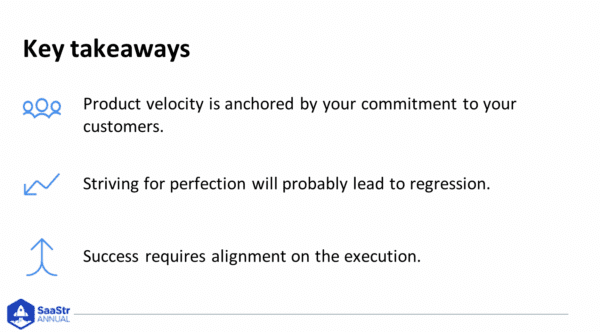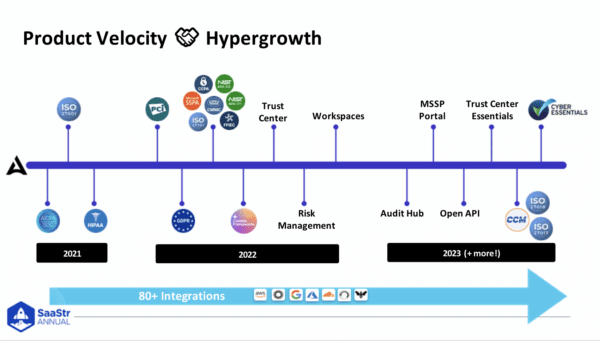How do you scale a product organization quickly?
VP of Product at Drata Brian Elmi and Director of Product Management Dana Mauger share five not-so-secret secrets of product velocity at SaaStr Annual this year. Spoiler alert: These are probably things you already know, but they’re much harder to do in action than in theory.
Let’s see how Drata does it — a relatively young company of only 2.5 years, has seen massive growth and over 14 different frameworks, trust center capabilities, Enterprise risk management capabilities, audit capabilities, work center capabilities, over 100 plus integrations, and 350 different features.
#1: Ship Fast. Iterate Faster.
At Drata, they have a principle to ship 60% of use cases really quickly because the opportunity costs of getting from 60% to 90% are enormous. You’ll spend a ton of time researching, making a lot of assumptions that are usually wrong, and slowing things down.
What does shipping at 60% mean?
You put the product in the hands of users and use real data from real users to measure success and determine how the features are being used. This creates a feedback loop from customers and partners that shows whether you’re on the right track or not. Then, you can modify the priority of the iterations that come next.
#2: Be Competitor Aware, But Customer Focused
Customer obsession is a core value at Drata. They take it one step before stalking. Yes, you need to be aware of what’s happening in the marketplace and with your competitors. But the bottom line is customers are the ones using your products, not competitors.
You’re solving customer problems and hopefully becoming a problem for your competitors. Companies could spend time reading competitor press releases and blog posts, and sure, you need to know some of that stuff. But the more energy and time spent focusing on competitors, the less time and energy you channel towards your customers.
At Drata, they have a team focused on building products and new functionalities and shipping big things. They also have a team entirely devoted to customer obsession. That second team is an opportunity to get smaller enhancements and delighters that didn’t make the roadmap.
A smaller customer-obsessed team shows the company is listening and can move quickly while also freeing up other teams focused on the bigger features. This secret is really the ethos of focusing on the customer, identifying their problems long-term, short-term, and immediate, and solving for those.
#3: Embrace Ruthless Prioritization
As a product manager, you might be a people pleaser who has to say no, not yet, or not now. This is especially true in the early days when you have so many things coming at you and goals you want to achieve. Something that is a no right now might be a yes a year or two from now. So, there has to be a balance between vision and execution.
As a product person, you must have a vision of where the product will be 2, 3, or 5 years from now. But if you spend too much time dwelling on that vision, you’ll lose sight of what’s important today. Your customers aren’t paying for a vision five years down the road. They’re paying for solutions that solve their problems today.
The takeaway?
You want to have a vision but be very focused on building, step by step, towards that and delivering value to your customers that they’ll pay for along the way. Don’t perfect that vision either because it’ll change as soon as your customers put their hands on it.
#4: Understand Vision vs. Execution
Striking a balance between vision and execution is crucial for any successful product strategy. The first step towards achieving your vision involves building it piece by piece, much like constructing a skyscraper. But remember, great products are continually iterating and improving over time.
In this process, customer feedback serves as an essential tool for adaptation. Imagine being on stage; feedback from your audience helps fine-tune your performance. So be sure to use every comment or suggestion that comes from users of your product as stepping stones leading towards perfecting your overall strategy.
The idea here is simple yet powerful: “Think Big, Start Small.”. This means having ambitious plans (think big) but beginning with manageable steps that can quickly adapt based on user response (start small).
To illustrate further:
- Vision: The end goal – what you ultimately want to accomplish.
- Execution: How you plan to reach there – strategies used and steps taken along the journey.
Rather than perceiving the challenge of balancing vision and execution in product strategy as a precarious tightrope walk, view it as a journey where you get to learn and adapt while moving closer to your destination with each step.
#5: It’s More Than Just Product
When thinking about scaling your product organization, look for three pillars.
- People
- Process
- Product
You want to focus on hiring the right people. Trust is a core value at Drata, so if it’s not a hell yes across the board for a new hire, it’s a no. For processes, you want to hone in on your processes and feedback loop early on. You want to build that from the ground up before you scale.
Drata has data points all the way from prospects and the features and capabilities they want, to customer success sharing how customers are using features, and sending that back to the product team. Round and round that feedback loop should go. Honing that process and cycle of real-time feedback helps you to understand your product and customers and build quickly around that.
And, of course, you want a product that solves the right problem. That combination of three pillars will help you scale.
Key Takeaways

Your commitment to your customers anchors product velocity. Trying to solve customer problems for your customers and getting the entire organization aligned around that will help you grow and scale quickly. Striving for perfection will probably lead to regression.
This is true in product development and life. You have to start applying those brushstrokes to get to the masterpiece. Be intentional about what you deliver now so the broader picture gets painted later. Success requires alignment on the execution.
It takes a village. You need a feedback loop between sales, customer success, and product. Make sure everyone is aligned throughout the organization — moving in the same direction so you can move forward quickly.


